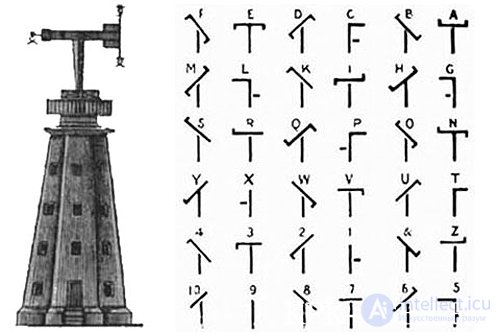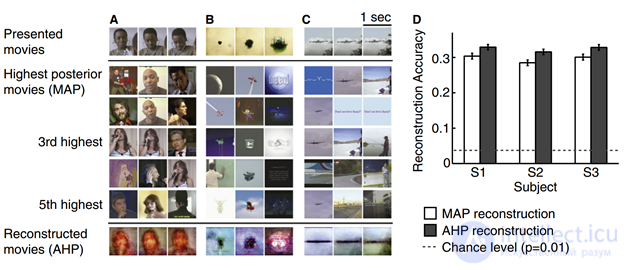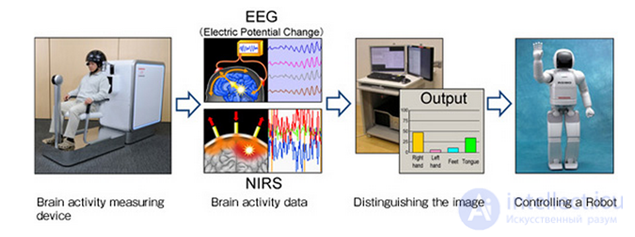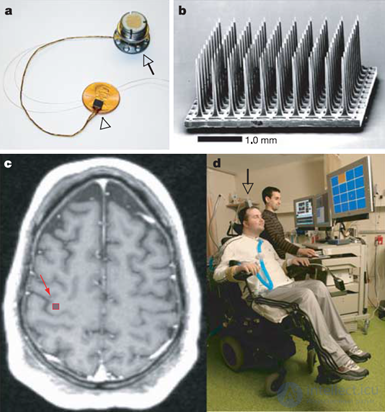For those who have just joined, I advise you to start with the first part, or at least with the description of the wave model of the cortex. Our wave model shows how the induced activity of the neurons of the cortex generates waves of background activity, propagating both within the zones of the cortex and through projection connections throughout the entire brain space. Passing through any part of the cortex, the wave encoding a certain phenomenon reproduces its unique pattern. This allows neurons anywhere in the cortex to receive information about what is happening in other parts of the brain.
Such a data transmission mechanism can be compared with an optical telegraph. Even before the invention of the wired telegraph for the transmission of messages over long distances used a system of towers in direct line of sight from each other. The position of the rails in a special design, mounted on the top of the tower, encoded the letters of the transmitted message. Each following tower repeated what it saw on the previous one. Now imagine that each of the semaphore towers does not repeat the signal, but works according to a more cunning algorithm. Each signalman gets a special notebook. When he sees a new pattern of rails for him, he writes it in a notebook in the first column and assigns to it another randomly chosen pattern, which he writes in front of him in the second column. The main thing is that this pattern is not used in the second column earlier. Accordingly, the work of the tower turns into a translation of some patterns into others. In this case, the unambiguity of such conversion is observed. No matter how many towers are in the path of a signal, the message will come in an information-holistic, albeit recoded form.
Now imagine that the towers are not arranged in a line, but evenly cover the whole earth. Then from each tower several neighboring ones will be visible. The table in the notebook signalman will have to complicate. He will need to have as many columns as towers he sees plus his own. In the new conditions, the signalman’s task will be to expose his pattern as soon as a new message appears on at least one of the neighboring towers. After all signalmen fill in their tables, each letter will correspond to a certain steady pattern of flags throughout the land. It will be enough to set a certain signal on one of the towers as it spreads around the world.

Let's change the work of imaginary towers. We put in place of a mechanism with flags flashlight. Communication between the towers will be reduced to monitoring the flashes of neighbors and filing your own flash if indicated by a note in the notebook. Keeping the notebook somewhat complicated. Now a new entry in it will appear under the following conditions. When a series of flashes occurs near the tower, the caretaker will check if there is a record of such a configuration in his notebook, and if there is, he will give a flash of his own tower and leave for the prescribed instructions for a few minutes. If there is no such record, he will wait until the wave of flashes passes and remembers the resulting pattern. Then he will calculate how many flashes there were around. If there were enough of them, that is, the pattern of the previous wave has already been formed by other lighthouse towers, then it will relax and go for tea, waiting for the next wave of flashes. Otherwise, he will start to flip a coin, for example, five times (depending on how many other towers he sees), if all heads are done five times, he will make a new entry in the notebook where the new pattern will be placed.
In order to send a message of one word in such a telegraph, it will be necessary at the point of departure to match the word with some pattern of towers located nearby. When these towers begin to flash (not once, but in a long series), the supervisors of the neighboring towers will start to play the toss and will gradually connect to the propagation of the wave pattern. When the entire beacon system learns this word, then it will be possible to detect its transmission anywhere in the world. At every point on the planet, this word will create its own unique pattern when passing a wave of flashes. But what is most interesting, we can choose any place and see which pattern corresponds exactly to the word of interest to us. If now we reproduce this pattern, causing the corresponding beacons to flash, then a wave of flashes reaching the addressee will create exactly the same pattern as if the message had been sent from the starting point. Actually, this is exactly how the brain works (in our theory). Concepts are encoded by patterns of neurons generating pulse packets. Waves of single pulses spread patterns identifiers throughout the brain. And such a mechanism underlies all subsequent information activities.
Let's go back to the bark. It is possible to judge what thoughts the brain produces in different ways. The easiest way is to analyze the readings of a multipoint encephalogram. Since different thoughts cause different from each other pictures of the activity of bark zones, certain patterns can be tracked and subsequently used. It is impossible to understand thoughts in this way, but different forms of brain activity can be approximately distinguished from each other. If desired, this can be used for simple control systems that do not require high accuracy or speed.
More advanced methods are fixing, for example, using a magnetic resonance tomograph, the level of oxygenation of blood flow in the cortex, which allows to judge about the places where the greatest neural activity is concentrated. The spatial resolution at the same time is many times higher than when using an encephalograph. For the primary visual cortex, where the topography of the projection is preserved, this method is at least very crude and inertial, but allows you to look into the thoughts of a person (figure below).
 Image reconstruction results (Shinji Nishimoto, An T. Vu, Thomas Naselaris, Yuval Benjamini, Bin Yu, Jack L. Gallant, 2011)
Image reconstruction results (Shinji Nishimoto, An T. Vu, Thomas Naselaris, Yuval Benjamini, Bin Yu, Jack L. Gallant, 2011)
Magnetic resonance imaging is cumbersome and not applicable for non-laboratory use. But there is a simpler way to measure the parameters of cerebral blood flow - this is a local infrared spectroscopy. A separate sensor consists of an infrared source and an optical receiver of the reflected signal. By changing the absorption spectrum, one can judge about the processes occurring directly under the sensor. Using a combination of infrared and electroencephalographic sensors, Honda has created an interface that allows you to control a humanoid robot with sufficiently high accuracy (Honda Research Institute Japan Co., 2009).
 Honda complex (Honda Research Institute Japan Co., 2009)
Honda complex (Honda Research Institute Japan Co., 2009)
The optical methods mentioned earlier allow us to obtain even greater detail of the activity of the cortex in space and time, but even they only give an idea of the collective activity of thousands of nearby neurons.
Averaging the activity of neurons over any part of the cortex loses information about the individuality of the wave pattern. For this activity, you can build rough assumptions about what is happening with the brain, but you can not get access to subtle information processes. Something similar can be observed with computers. By the activity of the individual modules and by analyzing the frequencies emitted by the computer, it is possible to judge what type of task it performs. For some programs, you can even get the hand at guessing individual actions, but this is not at all compared to what the connection to information buses gives you.
Methods of implantation of electrode arrays now allow access to the immediate activity of many neurons at once. In 2004-2005, the first experiment was performed on the implantation of such a sensor to a completely paralyzed patient. As a result, more or less adequate control of the prosthetic arm was achieved
(Leigh R. Hochberg, Mijail D. Serruya, Gerhard M. Friehs, Jon A. Mukand, Maryam Saleh, Abraham H. Caplan, Almut Branner, David Chen, Richard D. Penn, John P. Donoghue, 2006) (picture below).
 a) The matrix of electrodes on a one-cent coin and a plug inserted into the skull. b) Array of one hundred electrodes. c) Array location. d) First patient with an established interface (Leigh R. Hochberg, Mijail D. Serruya, Gerhard M. Friehs, Jon A. Mukand, Maryam Saleh, Abraham H. Caplan, Almut Branner, David Chen, Richard D. Penn, John P. Donoghue, 2006)
a) The matrix of electrodes on a one-cent coin and a plug inserted into the skull. b) Array of one hundred electrodes. c) Array location. d) First patient with an established interface (Leigh R. Hochberg, Mijail D. Serruya, Gerhard M. Friehs, Jon A. Mukand, Maryam Saleh, Abraham H. Caplan, Almut Branner, David Chen, Richard D. Penn, John P. Donoghue, 2006)
The array of electrodes used in the experiment did not differ in special accuracy of the connection to the cortex. Only part of the electrodes recorded the pulses of individual neurons, the rest transmitted the total activity of the neural groups. But even this experiment was enough to filter out quite useful information.
When the progress of technology will allow to remove at least a few hundred neurons from a small area of the brain, as I see it, this will be enough to create an artificial wave tunnel similar to those tunnels that connect different zones of the cortex. The analysis of wave activity patterns will allow not only to track the state of neuron detectors of a small portion of the cortex, it will allow to see the information waves passing through it and, accordingly, to get an idea of all the concepts with which this zone of the cortex works. It seems to me that a dozen of such tunnels, set aside from different areas of the brain, will allow you to transfer to the computer almost a complete picture of human thought. It will not be a photographic picture of what we see, or the sound of what we hear, but it will be a full-fledged reproduction of what we think.
If our concept is correct, then the wave tunnels can both read information and transmit it back. To transfer information from a computer to a person, you can either reproduce the patterns of previously read identifiers, or generate unique ones of your own. In the latter case, the brain will need to be trained to compare the waves created by the computer with the concepts that are already known to man.
If you take two people and connect them to a computer, and then translate the patterns using it, translating the patterns characteristic of one into patterns that match the same concepts from the other, you get a telepathic interface, the very crown of Professor Kazarin of Cyrus Bulychev.
The possibilities of the wave interface are not limited to telepathic communication between a person and a computer or people among themselves. If you reproduce the cerebral cortex on a computer, you can ensure that in the process of coexistence it absorbs a significant amount of memory and individuality of a person. It is possible that for a full-fledged transfer of personality it will take years of living together with a connected computer, but potentially this opens up the possibility of “soul relocation”. If you continue to fantasize, then nothing prevents you from connecting a trained computer to a pure biological brain and carrying out a gradual reverse transfer. Of course, it is interesting to speculate about what will happen to self-awareness during such travels, but this is a topic for another conversation.




Comments
To leave a comment
Logic of thinking
Terms: Logic of thinking